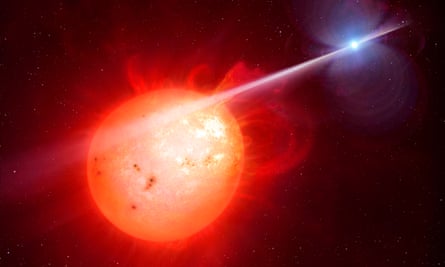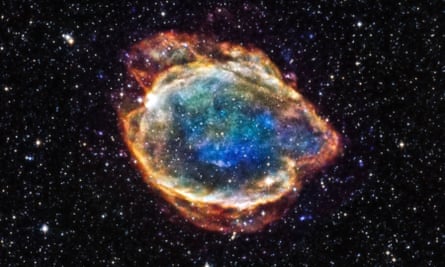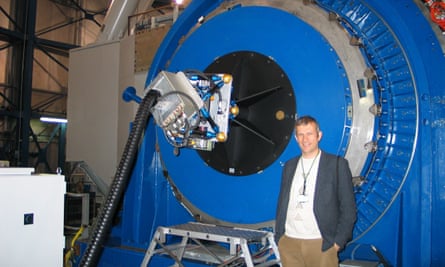Tom Marsh obituary | Astronomy
Tom Marsh, the founding professor of the astronomy and astrophysics group at Warwick University, who has died aged 60, was a world-leading expert on compact binary star systems, two stars closely orbiting around each other. It is believed that the majority of stars are in fact in binary systems, with some close enough to produce complex interactions.
As the two stars orbit each other, we see them alternately receding from us and coming towards us. When the light from the stars is spread out into a spectrum of wavelengths, we see the features in the stellar spectra moving backwards and forwards in wavelength as they are redshifted and blueshifted by the Doppler effect. Detailed observations allow astronomers to estimate the masses of the stars, and – if the stars happen to be lined up so that they eclipse each other – their radii, and the distance of the system.
Marsh’s special interest lay in binary systems in which one of the stars is a white dwarf, a dead compact object that represents the end-point for a star like the sun, while the companion is a normal star. If the stars are close enough, the normal star, as it evolves and tries to expand in size, is forced to funnel material towards the white dwarf. This material forms an accretion disc circling around the white dwarf that powers highly variable light output.

Material from the inner edge of the disc falls onto the white dwarf and can result in thermonuclear flashes, causing an enormous surge in brightness of the binary system. All these white dwarf systems are called “cataclysmic variables”. If enough material is dumped on the white dwarf the whole star may blow up as a Type Ia supernova.
Marsh spent a lifetime studying white dwarf binary systems with every telescope and instrument he could get his hands on. In 1988, with Keith Horne he invented a technique called Doppler tomography, in which the shape of the Doppler-shifted emission lines is modelled to create an image of the system and the accretion disc of gas and other matter, ideally followed through the whole orbit of the system. This image reconstruction technique provides an effective resolution which not only beats the “seeing” or twinkling effect of the earth’s atmosphere, but even the “diffraction limit” normally set by the wave theory of light.
He and his collaborators applied this technique to hundreds of binary star systems, and later to binary systems with neutron stars (even more compact relics of massive stars) and black holes. Highlights included two-arm spiral shocks seen in the accretion disc and cases where the strong magnetic field of the white dwarf channels a twisting flow of gas directly from the companion onto the white dwarf. In 2018 Marsh was awarded the Royal Astronomical Society’s Herschel medal for his pioneering research on binary star systems and for his development of the Doppler tomography technique.

Marsh loved to observe on the great telescopes around the world, but he also had an interest in the data analysis techniques and in the instrumentation needed to capture the best data. In 2007 he and his team, along with colleagues from Sheffield University and Edinburgh Observatory, including with his long-term collaborator Vik Dhillon, developed the Ultracam instrument. This camera can take 500 images a second and has been used on the William Herschel Telescope on La Palma in the Canary Islands, the Very Large Telescope in Chile, and, more recently, on the New Technology Telescope at the La Silla Observatory in Chile. It was during an observing trip at La Silla in September that Marsh went missing, and was found dead in the desert only a few miles from the observatory two months later.
Born in Old Windsor, Berkshire, Tom was the third of four children of Prudence (nee Holland), a teacher, and David Marsh, a systems engineer and manager at Ferranti. As a child he was given a telescope and a book about the stars, which launched his lifelong interest. From St Paul’s school, Barnes, south-west London, he went into industry for a year and then to Queens’ College, Cambridge, to study natural sciences, graduating in 1982.
He remained at Cambridge to study emission lines in cataclysmic variable stars” for his PhD (1986), and the topic became his life’s work. Posts followed at the Royal Greenwich Observatory, Herstmonceux, in East Sussex, and at the Space Telescope Science Institute, Baltimore. He then won a Particle Physics and Astronomy Research Council fellowship, which he took up first at Oxford and then at Southampton.

In 2003 he moved to the department of physics at Warwick University to start an astronomy research group there that has now grown to comprise 75 people, including 18 academics. He handed over the leadership of the group in 2020 in order to give himself more time to go to telescopes and study newly discovered binary systems. Recently he became interested in “multi-messenger” astronomy, which combines optical, neutrino and gravitational wave signals from the objects he studied.
In 1987 he married Felicity Brown, a writer and editor whom he had met at university. They had two children, Tabitha and Henry.
Read More: Tom Marsh obituary | Astronomy

